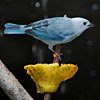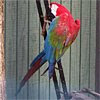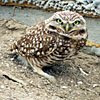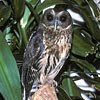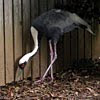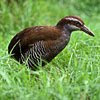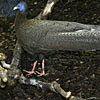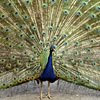Hiking
Simply driving through Zion is an incredible experience, but to enter Zion and not take at least a short walk would be almost foolish. The park is a hiker's mecca! The trails are of varying difficulty and length, ranging from easy strolls to steep climbs or backcountry hikes. The park information desk provides detailed information and overview maps for the main day hikes and trails ranging from short strolls to strenuous hikes of several hours. Longer backcountry hikes with overnight camping have to be discussed with the park rangers in order to reserve spots for the limited back country camp sites in the park.
The most famous trail, and arguably the most spectacular, is the 2.5 mile strenuous climb up to Angel's Landing. Of the easy walks, Weeping Rock and the Emerald Pools Trails are classics. For those seeking a longer, full-day hike, the classic Zion hikes are along the East and West Rims. And for serious backpacking, the Trans-Zion route is the full 48 mile hike across the entire park, from Lee's Pass in the west of the Kolob Canyons to the east entrance of the Park.
Zion-Mt. Carmel Highway and Zion Canyon trails
* Pa'rus Trail (3.5 mile / 5.6 kilometer round-trip). Trailhead is at Canyon Junction. An easy paved hiking/biking trail that follows the North Fork of the Virgin River from the Zion Canyon Visitor Center past the South Campground to the Zion Canyon Junction shuttle stop. This is the only trail in the park that allows pets or bicycles.
* Court of the Patriarchs (100 yards round-trip). Trailhead is at the Court of the Patriarchs shuttle stop. A very short trail leading to a view of the Three Patriarchs and the Sentinel.
* Weeping Rock (0.5 mile / 0.8 kilometer round-trip). Trailhead is at the Weeping Rock shuttle stop. A short but mildly steep, paved trail ends under a rock alcove with dripping springs. In the spring and summer, hanging gardens of wildflowers decorate the walls.
* Riverside Walk (2.0 mile / 3.3 kilometer round-trip). Trailhead is at the Temple of Sinawava at the end of Zion Canyon. An easy paved trail follows the North Fork of the Virgin River along the bottom of a narrow, high-walled canyon. The canyon is lush, with hanging gardens, trees, and wildflowers in spring and summer. A great walk if it's hot: the trail is shady and you can wade in the river. This is also the main access to the Zion Narrows.
* Canyon Overlook (1.0 mile / 1.6 kilometer round-trip). Trailhead is at the east end of the Zion-Mt. Carmel Tunnel. If you only have enough time to drive through the park without getting on the shuttle, make this your hike. This moderately difficult trail leads over rocky, uneven terrain to a spectacular viewpoint of lower Zion Canyon and Pine Creek Canyon.
* Lower Emerald Pool (1.2 mile / 1.9 kilometer round-trip). Trailhead is across the highway from the Zion Lodge. This is an easy paved trail that leads to the lower pool, just below the middle pools.
* Middle Emerald Pools (2.0 mile / 3.3 kilometer round-trip). Trailhead is across the highway from the Zion Lodge. A moderately difficult trail to the middle pools. Swimming, wading, or bathing is prohibited in all four Emerald Pools due to dangerous bacteria in the water and in order to protect the aquatic wildlife and preserve this fragile area. Careful: Steep cliffs, there has been at least one death from falling at one of the middle pools.
* Watchman (2.0 mile / 3.3 kilometer round-trip). The trailhead is near the Zion Canyon Visitor Center, just across the Virgin River. This moderate trail ends at a view point of lower Zion Canyon, Oak Creek Canyon, and the town of Springdale. It is recommended that the trail be taken at the beginning or end of the day due to the heat.
* Hidden Canyon (2.0 mile / 3.2 kilometer round-trip). This trailhead is at the Weeping Rock shuttle stop. A strenuous climb, with cliff side hiking, that is not for anyone who isn't in good physical condition or is fearful of heights. The trail climbs a steep cliff that offers incredible views of Weeping Rock, Big Bend, Angels Landing and the valley below. Chains have been put into the cliff near the end of the trail to provide handholds. The trail ends at the mouth of a narrow side canyon, which you can explore if you wish. Keep your eyes open for the arch located inside the canyon.
* Angels Landing (5.0 mile / 8.6 kilometer round-trip). The trailhead is at the Grotto. A steep, strenuous hike up the West Rim Trail to the Angels Landing Trail, which is a 0.5 mile / 0.8 kilometer spur. The trail follows a steep, narrow ridge with chains added to provide handholds. This spectacular trail ends at a magnificent overlook of Zion Canyon and the Virgin River. For those in good physical condition and not afraid of heights, this hike is a must.
Those afraid of heights can stop and turn around at 'Scouts' Overlook' where the final vertiginous ascent to Angel's landing starts. The hike to Scouts' Overlook only is strenuous but less exposed.
* Observation Point (8.0 mile / 12.0 kilometer round-trip). The trailhead is at the Weeping Rock shuttle stop. This is a strenuous climb through Echo Canyon to Observation Point, offering excellent views of Zion Canyon. The trail gives access to other East Rim plateau trails: East Rim, Cable Mountain and Deertrap Mountain.
* West Rim to Cabin Spring (10.0 mile / 17.2 kilometer round-trip). The trailhead is at the Grotto. This hike travels north through Refrigerator Canyon, up Walters Wiggles, through the basin refered to as Little Siberia and then finally ascends switchbacks blasted out of the solid rock face to the southern tip of the "West Rim". At one time a cabin existed near a small spring and was used as a remote station for Rangers. The views from the southern end of the West Rim are beautiful indeed, and in the spring months there may be water available, but should be filtered or purified.
* West Rim Trail from Lava Point (16.0 mile / 25.75 kilometer one-way). The full West Rim Trail is one of the best backcountry hikes that Zion (or any park, really) has to offer, and is the most popular section of the Trans-Zion backpacking route. It is best hiked top-down (north to south) both to avoid the extreme incline gain you would face going the other way around, and because the scenery starts out beautiful and with each steps becomes more and more spectacular until you hit the climax at the entrance to Zion Canyon at Angel's Landing. (This is also a great way to introduce yourself to Zion, if you haven't yet seen the main canyon.) It's possible to hike the whole trail in one day, although that would be incredibly strenuous hiking from south to north, but a two-day hike is far better to linger along the magnificent views, and to have plenty of time to enjoy the Angel's Landing hike at the end. There is a short spur at the top of the trail leading to Lava Point Overlook, which at 7890 feet is the highest point in the park, and as you might expect offers some magnificent views. This spur can easily be hiked in a couple hours round trip from the trailhead, for those not doing the full trail. At the south end of the trail, a hike up Angel's Landing is a must. At the north (west) end, the trail connects with the Wildcat Canyon Trail, which in turn connects to the Kolob Canyons section of the park.
Kolob Canyon and Kolob Terrace Trails
* Timber Creek Overlook (1.0 mile / 1.6 kilometer round-trip). Departing from the Kolob Canyons picnic area (at the end of Kolob Canyons Road), this easy trail follows the ridge top to small peak which offers views of Timber Creek, Kolob Terrace and Pine Valley Mountains.
* Taylor Creek (5.0 mile / 8.6 kilometer round-trip). The trailhead is on the Kolob Canyons Road, 2 miles east of the Kolob Canyons Visitor Center. This trek follows the Middle Fork of Taylor Creek past two homestead cabins to a gorgeous double arch alcove. Watch your kids since rattlesnakes are common on this trail.
* Kolob Arch (14.0 mile / 22 kilometer round-trip). The trailhead is at Lee Pass, 4 miles up the highway from the Visitor Center. A strenuous hike or backpack from Lee Pass (on Kolob Canyons Road) along Timber and LaVerkin Creeks to Kolob Arch, the world’s second longest freestanding arch.
* Northgate Peaks (4.0 mile / 6.4 kilometer round-trip). This is the only easy, day-hike friendly trail in the Kolob Terrace section of the park. There are certainly more exciting trails to be found in Zion, but here you'll find solitude, and have a great excuse to drive up the beautiful and remote Kolob Terrace Rd to the Wildcat Canyon Trailhead.
* Wildcat Canyon Trail (6.0 mile / 9.7 kilometer one-way) and the Connector Trail (4 mile / 6.4 kilometer one-way). These trails are used pretty much exclusively by backpackers, especially those aiming to hike the full Trans-Zion route, of which these two trails are the middle section, connecting the Kolob Canyons and Main sections of the park. Neither has the sort of spectacular rock formations and red slickrock for which the park is famous, and aren't really worth seeking out as day hikes, although Wildcat Canyon is certainly beautiful in its own quieter and thickly forested way. The Connector Trail is likely the park's most boring hike, as it exists mostly just so that backpackers can get from one section of the park to the other without hiking along the road. The Wildcat Canyon Trail runs from the Wildcat Canyon Trailhead in the west to the West Rim Trail near the Lava Point Trailhead; the Connector Trail runs from the west section of the former trail to the Hop Valley Trailhead in the west, where it connects with the Hop Valley Trail.
Rock Climbing and Canyoneering
Climbing in Zion or entering technical slot canyons requires appropriate hardware and skills. Individuals interested in climbing or canyoneering should check for information at the visitor center and be aware that some routes may be closed when peregrine falcons are breeding or conditions are unsafe.

Canyoneering is popular in Zion, but most canyoneers stick to easier canyons such as Orderville Canyon, Subway and even Keyhole and Pine Creek while others venture out to Behunin Canyon, Mystery Canyon, Lodge Canyon, Echo Canyon, Das Boot, Englestead Hollow, Spry Canyon, Icebox Canyon, Kolob Canyon and just outside the park Birch Hollow and Fat Man's Misery. Few attempt Imlay and Heaps, considered perhaps the most difficult technical canyons in the park.
Ranger Programs
* Ranger Programs - Daily activities held April-October include interpretive talks, hikes, shuttle tours, and evening programs at the Zion Human History Museum, Zion Canyon Visitor Center and the campgrounds. Topics cover geology, biology, and human history. Check the Zion Canyon Visitor Center or museum for times.
* Junior Ranger Program - Zion offers the typical park, Junior Ranger program, where parents help children obtain an activity booklet from the visitor center. Kids complete the self-guided program to earn a badge.
* Junior Explorer Program - This is a unique and impressive class room activity for kids ages 6-12. Sign up at the Zion Nature Center, located at the entrance to the South Campground. Most kids love this program!
*
Hotel List Around Zion National Park











